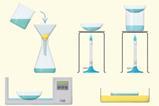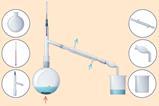Teaching students how to apply their knowledge regardless of context is key to successful outcomes in exams (and later in life). Here’s how to do it
When we are teaching and assessing chemistry, we need to be aware of both the concepts being studied and the contexts that help students engage with the sometime abstract concepts. Indeed, some exam boards provide specifications at GCSE and A-level that allow for a ‘concept-led’ approach and a ‘context-led’ approach. Students will have to answer questions in exams that are based on ‘unfamiliar contexts’. This should be seen as the end point of an education that has weaved concepts and contexts together in their wider chemistry education.

At all stages of education, we should be helping students to ‘develop a sense of excitement and curiosity about natural phenomena’ as the DfE’s guidance recommends and context helps us to do this. Setting up artificial barriers between concept and context can lead to a fragmented and unsatisfactory learning experience. The stories of chemistry are as interesting and relevant to the students as the core knowledge they have to learn. The tales of how Kekulé finally figured out the structure of benzene are as much a part of chemistry education as knowing about the conjugated ring structure. These tales also help to show chemistry for what it is – a human enterprise that applies a scientific method to our interactions with the material world. The importance of developing all students’ scientific capital is being increasingly recognised.
The RSC’s Education resources and STEM Learning are excellent sources of a wide variety of materials. I also particularly like the Essential Chemical Industry website, which provides detailed discussions of many industrial chemicals, and covers much of the content studied at 14–18.
The RSC’s Education resources (edu.rsc.org/resources) and STEM Learning (bit.ly/2lFjZJk) are excellent sources of a wide variety of materials. I also particularly like the Essential Chemical Industry website, which provides detailed discussions of many industrial chemicals, and covers much of the content studied at 14–18.

Current assessments used in England make a distinction between demonstration of knowledge and application of knowledge. For example, science GCSEs have assessment objectives (AOs) based around demonstration, application and analysis of ideas and information. The number of marks available in exams for these different types of questions are strictly controlled by regulations. The questions written by examiners to assess candidates’ abilities in application and analysis tend to be based on ‘unfamiliar contexts’. This helps to provide evidence that candidates can do more than just parrot back stock answers. It also introduces an element of unpredictability into the exams, which helps exams boards to reliably differentiate candidates year on year, and helps to limit grade inflation.
When some students first read these unfamiliar-context questions in exams, they can feel they are being asked about something they haven’t been taught. Witness the issues with ‘carrot-gate’ in a recent biology GCSE paper. In addition to teaching students about contexts found outside the course textbook, think about how you use past paper questions and how you model answering them.
Modelling with past papers
Completing past papers is an important part of revision, helping students to get used to the style of assessment and how to manage their time. However, don’t just stick to the questions available for the specification you are using. Many exam boards make their past papers available online, and some provide free access to their question selecting software. From these applications you can select questions based on a particular concept, widening the pool of exam writers’ work your students are seeing. Consider using questions from other sources such as Isaac Chemistry, question workbooks from publishing houses (eg CGP, OUP, Hodder etc) and general chemistry textbooks such as Chemistry in Context.
Completing past papers is an important part of revision, helping students to get used to the style of assessment and how to manage their time. However, don’t just stick to the questions available for the specification you are using (bit.ly/2ndmAuc). Many exam boards make their past papers available online, and some such as WJEC provide free access to their question selecting software. From these applications you can select questions based on a particular concept, widening the pool of exam writers’ work your students are seeing. Consider using questions from other sources such as Isaac Chemistry, question workbooks from publishing houses (eg CGP, OUP, Hodder etc) and general chemistry textbooks such as Chemistry in Context.
Interpreting exam questions is an important skill and one that needs to be explicitly taught. However, skills need time to develop – don’t leave it all to the revision period before the exams. Start by modelling to your students how to break down questions. Select a couple of good example questions, and show the students how you extract the key information – circling command words and underlining key information for example. Next discuss your thinking about which concepts you have identified as relevant. Jot down any key bits of information that may help you answer the question, then bullet point an outline of the answer. Finally, bring it all together by writing the answer, and check back that all command words and key information have been dealt with.
Make students set the question
Other techniques can be used as students progress through the course and have increasing knowledge and confidence. For example, provide students with three or four questions on the same area of the course and ask them to compare and contrast how the examiners have used different contexts. Stretch the students by asking them to write a further question within a different context.
Another useful technique is sometimes termed a ‘goal-free’ exercise, where you provide students with a prompt such as a diagram or apparatus set-up or chemical equation without any specific question. Students are then free to interpret the prompt from as many angles as their knowledge and understanding allow them. For example, a Boltzmann distribution graph may yield discussions ranging from an explanation of what the graph shows, through to how it changes when temperature is altered, or when a catalyst is added. An equation of the Haber process may yield dot-and-cross diagrams of the substances involved, a discussion of Le Chatelier’s principle, or an amounts of substance calculation. By not initially directing the student, you provide them with permission to think creatively.
Finally, practical work provides the context for many exam questions, particularly GCSE’s AO3 ‘analysis questions’. Give students time after completing a practical activity to discuss why a particular method or set of apparatus was used, how else the experiment could be carried out and in what other contexts the methods could be used.














No comments yet